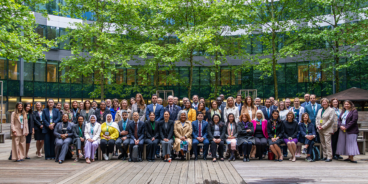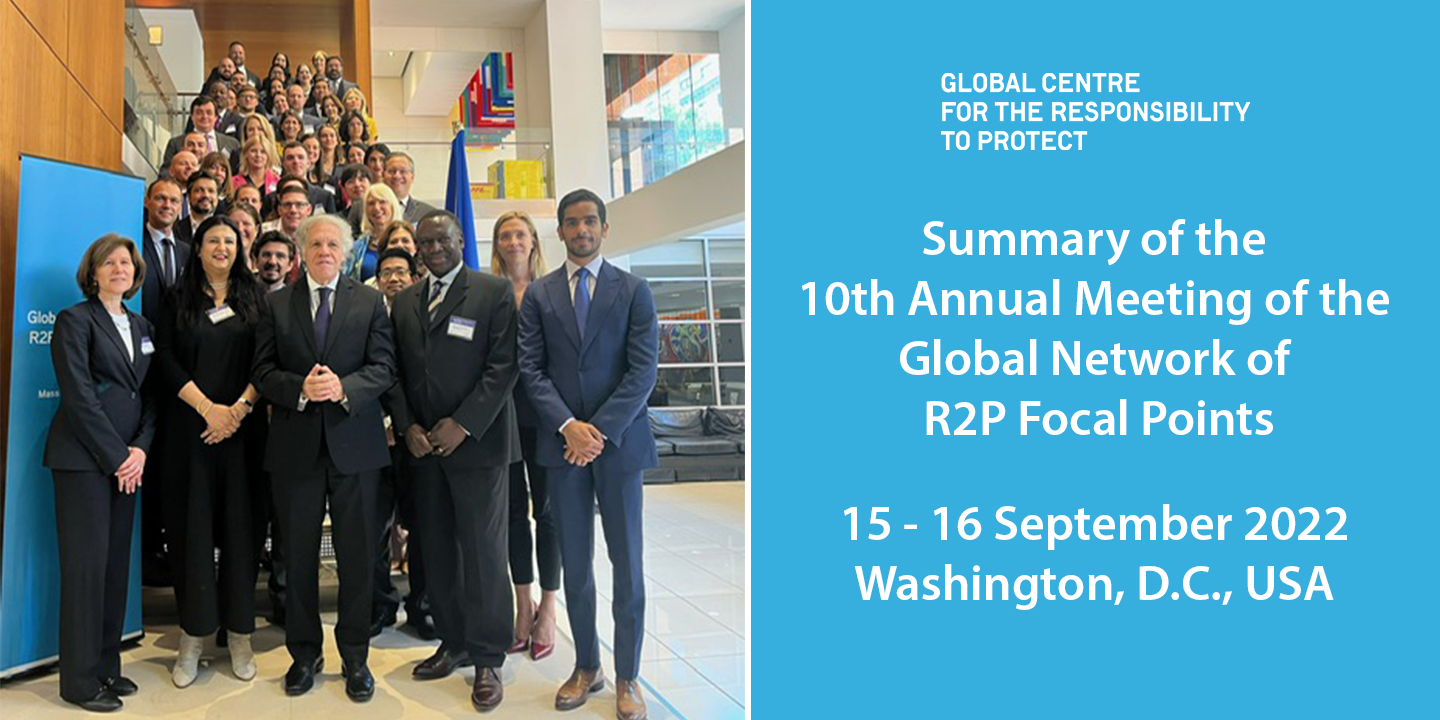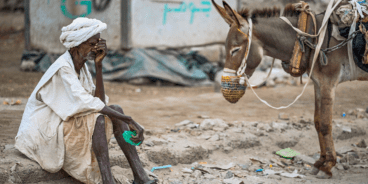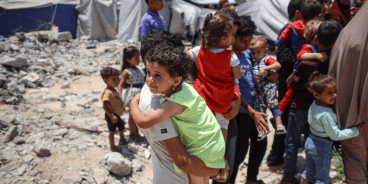

Summary of the 10th Annual Meeting of the Global Network of R2P Focal Points
The Global Network of R2P Focal Points held its tenth annual meeting from 15-16 September 2022 in Washington, D.C. The meeting, hosted by the Global Centre for the Responsibility to Protect at the headquarters of the Organization of American States (OAS), brought together senior officials from governments and regional organizations, the UN Special Adviser to the Secretary-General on the Responsibility to Protect (R2P) and members of civil society.
The tenth annual meeting provided R2P Focal Points with a platform to exchange ideas and experiences regarding the effective implementation of R2P, as well as on their individual roles in the prevention of atrocities. Participants considered how regional organizations contribute to the prevention of and response to mass atrocities and how these bodies can be essential tools in establishing hemispheres of peace. R2P Focal Points also reflected upon the experiences of populations in atrocity situations – examining the cases of Myanmar (Burma), Ukraine and Venezuela – and discussed regional and national responses to atrocity crimes.
The meeting also featured a panel discussion on the capacity of civil society to mobilize action on R2P and how members of the Global Network can better harness information gathered by civil society in their decision-making. In continuation of discussions at previous meetings, R2P Focal Points also addressed the linkage between R2P and the Women, Peace and Security (WPS) agenda and discussed the gendered dimensions of atrocity prevention, particularly with regard to women, girls and LGBTQIA groups as agents of change.
The following summary provides an overview of the key messages delivered by expert panelists, as well as the outcomes of discussions among R2P Focal Points during the two-day meeting.
OPENING CEREMONY
The meeting was called to order by the Secretary General of the OAS, H.E. Luis Almagro Lemes. He was joined by the UN Special Adviser on R2P, George Okoth-Obbo; the Assistant Secretary for the Bureau of Conflict and Stabilization Operations of the United States (US) Department of State, Anne Witkowsky; and the Executive Director of the Global Centre for the Responsibility to Protect, Savita Pawnday.
In his opening remarks, Secretary General Almagro emphasized the value of regional organizations and the relationship between upholding R2P and ensuring “hemispheres of peace.” He noted the decades of peace in his region and emphasized that the instrumentalization of R2P and other international principles emanates from the need to maintain this “regional peace.” Special Adviser Okoth-Obbo noted the role of R2P Focal Points, as orchestrators and translators for institutionalizing R2P within domestic and foreign policies. Pawnday stressed the significant normative progress since the global commitment to R2P was originally created, as well as progress towards accountability for atrocity crimes. In spite of unprecedented challenges posed by the ongoing Covid-19 pandemic, she noted the steadfast commitment of states and organizations within the Global Network to protect populations from genocide, war crimes, crimes against humanity and ethnic cleansing.
REGIONAL ORGANIZATIONS AND THE IMPLEMENTATION OF R2P
Regional organizations play a unique role in preventing and responding to mass atrocities, as well as in promoting individual and collective action by their member states. These organizations are often best placed to guide multilateral action on emerging atrocity risks in their region as they may have a better understanding of the relevant political and societal dynamics within member states where atrocities are taking place. These organizations are also composed of neighboring states who may be disproportionately affected in the aftermath of atrocities. Participants discussed how to proactively “regionalize” prevention strategies to address risk factors in their own neighborhoods. This includes working with other states to integrate atrocity prevention strategies that address structural risk factors within their countries, as well as taking collective action to respond to emerging situations within neighboring states.
While R2P may not be explicitly articulated in their charters or founding documents, many regional organizations have an institutional mandate that relates to atrocity prevention, as highlighted by Jared Genser, OAS Special Adviser on R2P, and Alexandre Polack, Deputy First Counsellor at the European Union delegation to the US. In this regard, the panelists discussed what tools regional organizations have for responding to emerging risks in their region and for assisting member states in the prevention atrocities. R2P Focal Points also discussed the role that some organizations play in alleviating atrocity risks in other regions through coordinated assistance and various forms of pressure.
On the margins of the meeting the OAS launched a report entitled, “The Responsibility to Protect and the Organization of American States: A Path Forward for Atrocity Prevention and Response in the Americas.” While the report specifically addresses the OAS context, its thematic findings and recommendations, such as to further develop early warning systems, may be applicable to other organization and regions.
IDENTIFYING SUCCESSES AND CHALLENGES IN PREVENTING ATROCITIES
In order to reflect on missed opportunities for prevention and challenges in how governments have reacted to atrocities, R2P Focal Points discussed three country situations: Myanmar, Ukraine and Venezuela. The US Under Secretary for Civilian Security, Democracy, and Human Rights, H.E. Uzra Zeya, opened the session, affirming the US’s commitment to atrocity prevention and response with the Elie Wiesel Genocide and Atrocities Prevention Act and the new “U.S. Strategy to Anticipate, Prevent, and Respond to Atrocities.”
The session featured a panel with individuals from the three focus countries, including H.E. Oksana Markarova, Ambassador of Ukraine to the US; Beatriz Borges, Executive Director of Centro de Justicia y Paz (CEPAZ); and Wai Wai Nu, Founder and Executive Director of the Women’s Peace Network. Panelists emphasized the importance of governments engaging not only with international civil society, but also with local actors, particularly victim and survivor communities and others affected by atrocities, to develop prevention strategies and responses that are rights-based and community-informed.
While all three countries have faced unique challenges, several lessons learned emerged across the session. Participants raised the need for a holistic response that accounts for the multi-faceted nature of certain situations – where economic and humanitarian crises trigger political repression or conflict and vice versa – to ensure that the risk of atrocities is not deprioritized among other intersecting concerns. Moreover, participants noted that the international community should take early, informed approaches to influence changes in behavior before crimes have taken place. More often than not, the international community fails to respond to early warning signs. Instead of taking early, preventive steps, the international community is typically reactive when mass atrocity crimes are already occurring and relies upon responses grounded in punitive measures and condemnation.
Acknowledging that R2P Focal Points have a special responsibility to communicate the urgency of atrocity situations to their political leadership, even when the affected country is not necessarily a foreign policy priority for their government, participants also discussed factors that can create and expand the political will to respond to atrocities in a timely and effective manner. In this regard, participants discussed how to learn from the unprecedented, wide-ranging international response to the Russian invasion of Ukraine to generate meaningful reactions when atrocities and other grave breaches of international law occur elsewhere. This discussion also highlighted the importance of creatively engaging with UN agencies and decision-making bodies, regional organizations and other stakeholders in light of ongoing disagreements and conflicts of interest on the UN Security Council (UNSC).
THE ROLE OF CIVIL SOCIETY IN MOBILIZING ACTION TO UPHOLD R2P
Civil society organizations (CSOs) are key actors in preventing serious human rights violations and atrocity crimes. CSOs are often the first to witness the indicators of mass atrocity risks and are equipped with in-depth understanding and expertise that states should incorporate into any atrocity prevention response. Civil society is also at the forefront of promoting justice and accountability, monitoring and reporting on international law violations, working directly with affected communities and mobilizing action on the national, regional and multilateral levels.
This session featured presentations by Maria Eugenia Carbone, Director of the Latin America Program at the Auschwitz Institute for the Prevention of Genocide and Mass Atrocities; Naomi Kikoler, Director of the Simon Skjodt Center for the Prevention of Genocide at the US Holocaust Memorial Museum; Kate Ferguson, Co-Executive Director and Head of Research and Policy at Protection Approaches; and Andrei Serbin Pont, Director of CRIES. The discussion explored how R2P Focal Points can institutionalize relationships and engage with CSOs when developing strategies to implement R2P. Participants also discussed how governments can support the activism of local community actors, including women, youth and racial, religious and ethnic minority groups, to ensure a more coordinated and holistic approach to atrocity prevention.
Many states within the Global Network noted the positive role that CSOs play in strengthening prevention in both domestic and foreign policy, including through providing strategic policy advice, risk analysis and dissemination of information collected by civil society actors and affected communities. Government engagement with CSOs presents opportunities for dialogue to clarify what makes atrocities distinct from other forms of violence and how to tailor responses. Consultations between CSOs and their national governments have also contributed to the development of policies that enable government offices and ministries to have explicit conversations on atrocity prevention. While these conversations may not prompt the institutionalization of R2P specific language, by enabling understanding of the additional context, terms and concepts around atrocity prevention they may strengthen the work of those who are engaged and motivated to respond.
GENDERING R2P
Understanding the linkages and gendered dynamics of atrocities can help governments, regional organizations and the international community to holistically protect populations at risk. Gender equality, women’s empowerment and the protection of women’s rights – principles that are integral to the WPS agenda – are also intrinsic to the prevention of atrocities and conflict.
The panel featured remarks from Hilary Anderson, Senior Gender Specialist at the Inter-American Commission of Women; Katrina Fotovat, Senior Official at the US State Department Office of Global Women’s Issues; and Jaclyn Streitfeld-Hall, Director of Policy and Research at the Global Centre for the Responsibility to Protect. Panelists explored methods to achieve a holistic, gendered and intersectional approach to identifying risks, preventing atrocities, holding perpetrators accountable and reconciling communities.
States and regional organizations have undertaken numerous measures to uphold commitments to R2P and WPS in parallel, including adopting conclusions on WPS and sexual and gender-based violence (SGBV) that address atrocity risks, integrating a gender perspective and applying the atrocity prevention lens to all of their work across the conflict cycle, and appointing both an R2P Focal Point and WPS Focal Point who can work collaboratively on shared agendas. Despite some progress in integrating gender within R2P, the institutional frameworks that influence policymakers and actors in the field still often lack a nuanced approach to including women’s experiences within atrocity prevention or the inclusion of a gendered lens more broadly.
In addition to addressing SGBV and the risk of atrocity crimes, participants discussed how to expand their understanding of the nuanced role gender plays in atrocity prevention. There is sometimes a conflation between the WPS agenda, women issues and gender that does not recognize the full spectrum of gendered vulnerabilities, such as risks unique to men or members of the LGBTQI+ community. R2P Focal Points recognized that violence experienced by women in situations of mass atrocities is not always sexual in nature, and that other gender identities may experience sexual violence. States were urged to adopt an approach that considers structural gender inequality as a potential risk factor of atrocities.
ATROCITY PREVENTION IN PRACTICE: MECHANISMS FOR IMPLEMENTING R2P
States, regional organizations and multilateral bodies have developed and supported various mechanisms and tools to prevent atrocities and implement R2P. These range from mechanisms for enhanced early warning and risk assessments, to national policies and practices that support diversity and curb hate speech, to establishing international investigative mechanisms that collect and preserve evidence of ongoing atrocities and other actions at the UN Human Rights Council and UNSC that bring attention to specific country situations where civilians are at risk of atrocities.
During this session, participants identified and discussed good practices in atrocity prevention that R2P Focal Points and their governments can implement. The session included remarks by Special Adviser Okoth-Obbo; H.E. Mutlaq Al-Qahtani, Special Envoy of the Minister of Foreign Affairs of Qatar for Counterterrorism and Mediation of Conflict Resolution; Martin Mennecke, Academic Adviser to the Ministry of Foreign Affairs of Denmark and Professor at the University of Southern Denmark; Rebecca Barber, Mary Wing-Ming Lee Senior Human Rights Research Fellow, Asia-Pacific Centre for the Responsibility to Protect.
The Global Network also consulted on the creation of a global “Framework for Implementation.” The proposed document seeks to collate best practices and lessons learned on atrocity prevention into a comprehensive, actionable framework detailing how states can implement R2P within their domestic and foreign policy.
Participants also stressed the importance of establishing a historical memory for the Global Network to ensure accurate, transparent and consistent understanding of best practices for implementing R2P. One speaker recommended that prior to the annual meeting each R2P Focal Point prepare a one-page report on the progress made within their system on atrocity prevention over the course of the past year. Other suggestions included holding regular regional meetings for R2P Focal Points to provide an opportunity for collaboration and knowledge sharing among neighboring states.
RECOMMENDATIONS
Several key recommendations emerged during the two-day meeting. These recommendations are relevant for individual R2P Focal Points, as well as states, regional and international organizations.
-
- States, as well as regional and international organizations, should prioritize the protection of vulnerable populations from mass atrocity crimes. R2P Focal Points can play an essential early warning role by helping their governments identify situations that may escalate and mobilizing appropriate preventive action that accounts for and addresses atrocity risks.
- R2P Focal Points should raise awareness of R2P and its three pillars within their respective governments and institutions. R2P Focal Points should strive to create conditions for cooperation within their governments, including by linking atrocity prevention to other domestic and foreign policy initiatives (e.g. peace and security and environmental policy).
- R2P Focal Points should utilize the Global Network as a collaborative forum where they can support and work with one another by sharing experiences, analysis and assessments; developing joint positions and strategies; and sponsoring local and/or regional interactive panel discussions and sessions, within their own capacity.
- R2P Focal Points and their governments, as well as regional and international organizations, should build constructive working relationships with civil society. R2P Focal Points should strengthen their collaboration with CSOs and victims and survivor groups to build a rights-based and community informed understanding of atrocity risks and the needs of populations most affected.
Related Content


Atrocity Alert No. 443: Sudan, Israel and the Occupied Palestinian Territory and United States Travel Ban
